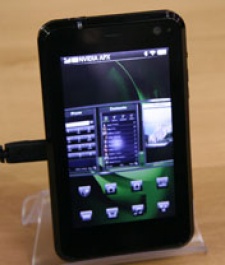If there's one thing Nvidia's successfully proved over its 15 or so years, it's that you need to continually push the boundaries of 3D graphics. From PC standalone graphics cards to professional multi-screen solutions, through to more recent developments such as its CUDA streaming technology and Telsa GPU super-computers, Nvidia's bottomline has always been that people will find uses for better 3D performance and hence pay for it, too.
And now it's bringing that philosophy to mobile with its frankly insane APX 2500 chipset.
We say insane because at last week's Mobile World Congress, Nvidia was demonstrating something of the potential of the technology by running a high definition movie stream (H.264 at 720p, if you're interested) direct from the APX 2500 development hardware via an HDMI connection onto a 60-inch plasma screen.
As as well top quality video and audio, the integrated APX 2500 chipset also offers superb 3D graphics performance through its Ultra Low Power GeForce core (compatible with OpenGL ES 2.0 or Direct3D Mobile), which can obviously be used both for gaming as well as new User Interfaces. For example, the APX 2500 development hardware is mounted within a PDA-style touchscreen device and at MWC, Nvidia was running a UI (user interface) that adopted a carousel approach so you could rotate between different applications by flicking them with your finger and selecting them with a double tap.
Another neat UI touch was the Mac-style Widgets, which are live streaming nuggets of data such as stock prices, news feeds, weather and maps. These can be toggled with the main application via a smooth transparency fade between the two.
The APX 2500 also supports cameras of up to 12MP resolution, with imaging and video stabilisation, as well as slots for MicroSD and USB. To complete the technical specification, the Windows Mobile platform has an ARM 11 CPU with 32KB L1 cache and a 256KB L2 cache. The integrated chip is fabbed at 65nm.
So, as we say, the power of the APX is frankly insane.
What's more significant however is how it will find its way into the market. Nvidia spokesmen suggested retail devices using the APX 2500 could be on the shelves by late 2008 or early 2009.
But there's a big difference between 'could' and 'will', and that's the difference between creating the APX 2500 chipset impressive as it and its development tools appear to be and getting it into high volume production with smartphone and PDA manufacturers.
Indeed, compared to the success of other companies in this area notably Texas Instruments with its OMAP 2, and Qualcomm Nvidia doesn't have much experience of selling chips into the market, which could prove to be a steep learning curve, especially as its limited to the minority Windows Mobile smartphone (so don't expect to see Nokia adopting it any time soon).
But, as it's proved over the years, pushing the boundaries of 3D graphics is the future. The only question is how fast Nvidia's future dreams for mobile will materialise.
Nvidia's insane 3D mobile tech: APX 2500
It's competition for the 'next iPhone', seemingly





















